|
|
|
|
|
|
|
|
|
|
|
||
|
|
by Roger Huntington ~ Reprinted by from Car Life April 1967 ~ Vol. 14 No. 3 |
|
|||
|
|
|
|
Just such a car is available now at Oldsmobile dealers. The car represents Detroit's first serious effort at a specific car design to meet the challenge of the 41,000-mile network of interstate super highways to be completed early in the 1970s. Efficient, high-speed, long-distance travel on these highways calls for a very special combination of equipment that cannot be readily "designed" on current option order forms.
Oldsmobile engineers have taken the first significant step with their development of the "Turnpike Cruising Package", cataloged as Option L-66. This package is available with F-85 Cutlass Supreme coupes, hardtop coupes and convertibles -- models which also are offered with the 4-4-2 high-performance package. The Turnpike Cruising Package basically is a special 400-cu. in. high-torque economy engine, 3-speed Turbo Hydra-Matic transmission, 2.56 axle gear ratio, 4-4-2 heavy-duty suspension, including springs, shock absorbers and front and rear antiroll bars and 7.75-14 white-stripe nylon tires. The list price of the complete package, including the Turbo Hydra-Matic, is only $380 over the cost of the standard 330-cu. in. V-8 and 3-speed manual transmission in Cutlass Supreme models. A price breakdown on the options is $142.18 for the L-66 Turnpike Cruising Package and $236.97 for the M-40 option, which is the Turbo Hydra-Matic. It appears a very reasonable price for what is delivered. (As released for sale, the Turnpike Package will carry a 2.56:1 axle rather than the test car's 2.41 ratio.) Consider that Oldsmobile engineers believed from the start that the key to the entire problem was use of the lowest possible rear axle gear ratio, while retaining brisk acceleration in the medium speed range. Axle ratio is by far the most important factor in high-speed fuel economy, much more important than total piston displacement, stroke length, camshaft timing and carburetor calibration. Internal engine friction increases roughly as the square of rpm, and is relatively unaffected by the load on the engine or the degree of throttle opening. The ideal situation for fuel economy then is to cause the engine to lug at low to medium speed. This is accomplished by the low axle ratio. |
|
|
|
The useful engine range with the test car's gearing is not 2000-5000 rpm as it is with normal high-performance gearing. It is 1000 rpm to not over 3000 rpm. The 3000 rpm figure represents about 65 mph in second gear and nearly 100 in high. And, the engine is designed for mid-range torque, not top-end horsepower. This is not as complex as it sounds. Oldsmobile engineers accomplished this feat by merely taking a 400-cu.in. 4-4-2 engine, including the large valve heads and 10.5:1 compression, and installing a 2-barrel carburetion system and a special short-duration, low-overlap camshaft. The carburetor is the 2-barrel Rochester with 1.687-in. throttle bores that is used for many other 1967 Oldsmobile engines. This unit is mounted on a standard manifold. Venturi area actually is quite large for a 2-barrel carburetor, but this makes it a good compromise on breathing. However, the camshaft is the key. Intake duration is reduced from 286 to 250º, and from 286 to 264º on exhaust. Overlap is reduced from 58 to 36º, and lift is reduced from 0.435 on the special Turnpike Cruising package camshaft. Actually, the lift rates are high on the latter, because of the short duration. For this reason, Turnpike engines float valves at 4700 rpm, compared with 5100 for the 4-4-2.
Special camshaft and carburetion systems completely transform the performance of the 4-4-2 engine. Advertised peak power is down from 350 bhp at 5000 rpm to 300 bhp at 4600. But peak power, as noted earlier, has little significance in the overall performance picture. The vital point of maximum torque is dropped from 3600 to 2600 rpm. The two torque curves cross at 2900 rpm. Thus it can be seen that the Turnpike engine develops greater torque at all speeds below 100 mph in high gear. Well down at 1200 rpm, 40 mph in high, the Turnpike engine delivers 390 lb.-ft. of torque, compared with the 350 for the 4-4-2. This makes a definite difference in throttle response. The Turnpike Cruising Package, however, would fall on its face without a good 3-speed torque converter transmission. With the low axle ratio, it is as important to have a close-ratio kickdown gear for passing, as it is to have very high overall torque multiplication at breakaway for adequate standing-start acceleration. The Turbo Hydra-Matic low gear ratio is 2.48. Stall torque multiplication of the converter is 2.20:1 with the stator in low pitch. As overall breakaway ratio of 2.20 x 2.48 x 2.41, or 13.2:1, is the result. This produces rubber-burning starts and 0-30 mph acceleration within 3 sec. Of course, the switch-pitch feature of the transmission is very useful on streets and highways because a small extra surge is available without actually kicking down into the next gear; it's almost like having a 4-speed transmission. However, the Turnpike Cruising Package would be impractical with either a 4-speed manual transmission or the 2-speed Jetaway used in standard F-85s.
THE TURNPIKE engine includes another feature that contributes a great deal to fuel economy. This is the new "Climatic Combusion Control" air intake system, which is option No. K-50, available at $33.70 on all Olds V-8 engines. The system employs vacuum-operated valves in the air cleaner housing to mix warm underhood air with hot air from a muff around the exhaust pipe to maintain a constant inlet air temperature of approximately 100º F. Warm air arrives at the carburetor within seconds after a cold start. This, for all practical purposes, carburetor air temperature remains constant. The system offers several advantages, including close control of exhaust emissions to meet antismog laws. What helps overall fuel economy most, however, is that the carburetor can be calibrated for the constant 100º intake temperature. Normally, the carburetor must be jetted for the lowest underhood temperature in normal operation, which can be as low as 20 or 30º F in northern states. Tests who the difference in overall fuel economy is 0.75-1 mpg. Olds decided to include the air temperature control system in the Turnpike Cruiser Package to derive that last ounce of fuel economy. Concern that hot carburetor air will reduce power on full-throttle acceleration is unfounded. The system is designed so the air valves close and admit only underhood air through twin snorkels when manifold vacuum drops below 6-8 in. Hg. Tests show the carburetor inlet air temperature drops from 100º to the underhood temperature (or close to it) within 2 sec. after the throttle is opened. Heavy-duty 4-4-2 suspension components are a vital part of the Turnpike package. A relatively firm suspension always is more restful for long highway trips because less pitching motion occurs. Soft suspension is best at lower speeds around town. perhaps the most important ingredient is the increase in rear roll stiffness given by the rear antiroll bar in the 4-4-2 package. This keeps the rear end from walking from side to side in crosswinds. It also gives the car a more neutral feel on curves and lessens steering effort. |
|
|
|
Several other options help the highway performance of the Turnpike Cruiser. Oldsmobile's new capacitor-discharge ignition has no breaker points and is less affected by spark plug fouling, hence full acceleration always is available without missing, even after hours of slow city driving. The optional Cruiser Control automatically maintains a constant pre-set speed on the road. With the new 1967 F-85 system, speed is not set on a dial. A button on the control system locks on that speed. Touching the brake pedal instantly releases the speed control mechanism. New UniRoyal radial-ply tires, expected to be an F-85 option by the time this reaches print, offer slightly less rolling resistance, which is said to improve fuel consumption by 0.5 mpg at highway speeds. The radials also offer long wear and a good ride. European radials tend to deliver a thumpy ride because of stiffer belts under the treads. Apparently Akron is making progress. What does this special package engineering really offer in usable performance? Oldsmobile has achieved a compromise between brute acceleration and good fuel economy. HERE ARE precise mpg figures measured on the GM Proving Grounds with fuel meter and fifth wheel, running at constant speeds in 40º weather:
Here are the acceleration figures, compared with the standard 4-4-2:
Very impressive! The car proved extremely responsive to the throttle in the 50-70 mph range, with engine speed at approximately 2000 rpm. At lower speeds, with the engine turning in at the 1000-1200 range, plenty of response remained because of the short-duration cam, but the converter dropped into low pitch more frequently. Those who desire additional performance can kick down into low gear at 30-40 mph. The pitch switched at about half throttle and kicked down at the detent point beyond full throttle. The excellent breakway acceleration with the 3-speed converter already has been discussed. Nothing was sacrificed because the short-duration camshaft pulled hard at stall speed. This would not be true with the hotter 4-4-2 camshaft. To reiterate, the secret of this car is the brilliant combination of camshaft timing, carburetion and gearing.
It's out on the highway that this engineered blend really comes into its own. One doesn't realize there is an engine pulling. It feels as though the car is being whisked along by a silent electric motor. There are no engine sounds or vibrations. The engine can't be heard even at 90 mph. Where it may be difficult to control other cars at 60-70 mph, the Turnpike Cruiser creeps effortlessly up to 80 and 90 and even 100. Cruise Control is a good preventive for speeding tickets as well as for tired throttle feet. It is safe to predict that Oldsmobile's new Turnpike Cruiser will be widely copied in the next few years. This is a new concept in automotive package design: Top-end power is ignored; the aim is for low- and mid-range torque. A very low final drive ratio keeps the engine in the middle of it's speed range in all normal driving. The torque converter 3-speed automatic provides adequate breakaway acceleration. Low engine speed insures smooth, quiet city and highway cruising. Reduced engine friction and pumping loss means good fuel economy with very little sacrifice in acceleration. The Turnpike Cruising Package may be the prototype of tomorrow's passenger car. |
|
|
|
|
|
|
|
|
|
CAR LIFE ROAD
TEST |
|
|
|
|
|
|
|
|
|
|
|
|
|
|
|
|
|
||||
|
|
|
|
|
|
|
|
|
|
|
||||||||||||
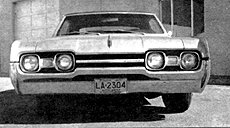 1967 Oldsmobile
Cutlass Supreme |
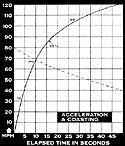 Acceleration and Coasting Chart CLICK TO ENLARGE |
|
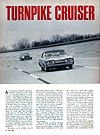 |
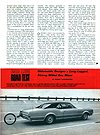 |
 |
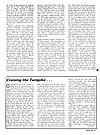 |
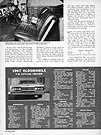 |
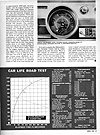 |
|
|
|
|
|
|
|
|
|
Want to link to this site? Please
use this banner. The correct URL for this website is http://www.OLDSmobility.com/) |
|
|
|